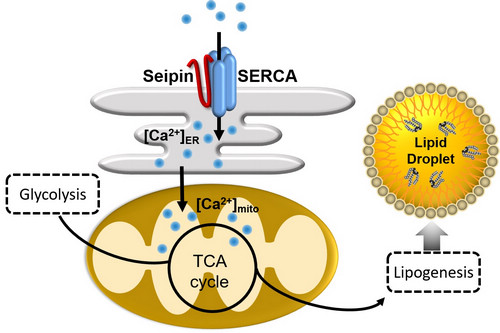
Adipose tissue dysfunction disrupts physiological homeostasis and endangers human health. Type II congenital generalized lipodystrophy (CGL2) caused by Seipin gene mutation exhibits almost total loss of adipose tissue in man. The pathogenesis of CGL2 and the molecular function of Seipin protein have not been fully understood
Prof. HUANG Xun's group at the Institute of Genetics and Developmental Biology, Chinese Academy of Sciences, collaborating with SHUI Guanghou's group, WANG Guodong's group and DING Mei's group, revealed that Seipin could regulate adipose tissue lipid storage via calcium (Ca2+)-dependent mitochondrial metabolism.
"This study not only provides a new insight into the molecular mechanism of organismal lipid metabolism regulation, but also suggests multiple potential therapeutic approaches for CGL2 syndrome", said Prof. HUANG.
HUANG's group has a long-term interest in studying lipid metabolism regulation. Their previous study indicated that Seipin regulated fat storage of adipose tissue and non-adipose tissue in a tissue-autonomous manner in Drosophila Seipin mutants.
In adipose tissue, Seipin interacts with ER Ca2+ channel protein SERCA to promote fat storage by maintaining the cellular Ca2+ homeostasis. However, the downstream responsive effectors of calcium signaling mediating the lipid storage remained unknown.
Recently, HUANG's group found that the mutant fat cells suffered from a metabolic bottleneck in channeling glycolytic metabolites to mitochondrial TCA cycle through metabolic analysis.
Furthermore, Seipin mutant fat cells have elevated mitophagy and low level of mitochondrial Ca2+.
They also found that the fat storage phenotype of Seipin mutants could be rescued by genetically rebalancing the mitochondrial Ca2+ and dietary supplementation of the metabolites (citrate).
Together, they proposed that in Seipin-deficient fat cells, the imbalanced ER Ca2+ causes the reduction of mitochondrial Ca2+.
This leads to the reduced activity of TCA cycle and decreased production of the substrate (citrate) for lipogenesis, and eventually lipodystrophy, according to the scientists.
The findings, revealing a "Seipin/SERCA-Ca2+-mitochondrial metabolism-fat storage" axis, have been published online in EMBO Journal entitled "Seipinregulates lipid homeostasis by ensuring calcium‐dependent mitochondrial metabolism".
The work was supported by the Strategic Priority Research Program of the Chinese Academy of Sciences, the National Key R&D Program of China and the National Natural Foundation of China.

Seipin regulates lipogenesis and fat storage through Ca2+-dependent mitochondrial metabolism (Image by DING Long)

86-10-68597521 (day)
86-10-68597289 (night)

52 Sanlihe Rd., Xicheng District,
Beijing, China (100864)

